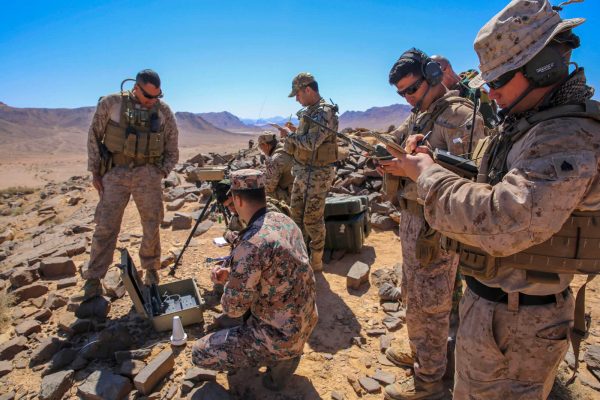February 19 marked the 75th anniversary of the first battle of Iwo Jima, and we honored this day with a post on the Navajo Code Talkers and photos of the men in Iwo Jima. If you haven’t read that post yet, please check it out.
In this post, we thought we’d go into more detail on the Navajo Code Talkers and share our own experience where we actually met one of these men back in 2010.
History of the Navajo Code Talkers in WWII
The Navajo Code Talkers were an elite group of men, recruited by a civilian named Phillip Johnston who was fluent in the rich and complex Navajo language, and who saw its potential for the development of an indecipherable code. In 1942, the “original 29” — as the first group of recruits reverently came to be known — began development of a code that started as 200 terms and was expanded to 600 by war’s end. These soldiers were sent to Marine divisions stationed in the Pacific and, during the first 48 hours of the Battle of Iwo Jima, they coded over 600 transmissions with impeccable accuracy and speed unmatched by coding machines. They became “living codes” due to the fact that no part of the code was allowed to be written down, and they gained a reputation for their amazing abilities, their heroism and their patriotism. To this day, the code used by these men is considered to be one of the most successful ever created and it was pivotal to the Allies’ victory.
Because the code was classified until 1968, the Code Talkers returned home as unsung heroes following the war, and their contributions remained virtually unacknowledged. It was not until 2001 that they finally received meritorious recognition in the form of the Congressional Medal of Honor.
Navajo Code Talker visits REDCOM in 2010
 In 2010, REDCOM welcomed one of the Navajo Code Talkers, Mr. Bill Toledo, as a guest of honor to a training event we held for our government and military customers in Rochester, NY.
In 2010, REDCOM welcomed one of the Navajo Code Talkers, Mr. Bill Toledo, as a guest of honor to a training event we held for our government and military customers in Rochester, NY.
Bill Toledo was born in Torreon, N.M., on March 29, 1924. He enlisted in the U.S. Marine Corps in 1942 and attended the Navajo Code Talker School at Camp Elliot, Calif., where he learned to use the Navajo language to help outsmart the Japanese in World War II.
Toledo spent three years as a Code Talker and was involved in three combat landings: Bougainville in the British Solomon Islands in November 1943, Guam in the Marianas Islands in July 1944 and Iwo Jima in the Volcano Islands in 1945.
On the island of Guam, while filling in as a messenger, he narrowly escaped sniper bullets by means of some quick footwork. Impressed by his moves, some of the Marines jokingly asked about Toledo’s football career before the war. Not all Marines were so jovial, though. On one occasion, while marching through the jungle, Toledo was mistaken for a Japanese soldier and taken prisoner. After being marched back to headquarters at gunpoint, he was assigned a bodyguard to avoid future misunderstandings.
Mr. Toledo passed away in 2016 at the age of 92, but we are honored to have met him and listened to him share his story with us.
Remembering Iwo Jima
The battle for control of Iwo Jima ultimately lasted 36 days. 5,931 Marines were killed in action, which is twice the number of Marines killed in all of World War One. An additional 209 deaths occurred among the Navy corpsmen and surgeons assigned to the Marines. The Fifth Fleet and participating U.S. Army and Army Air Corps units suffered other fatalities during the battle. The fatalities could have been far worse, however, without the help of the Navajo Code Talkers and their unbreakable code.
75 years later, as REDCOM works on securing the communications for our warfighters today, we honor the sacrifices made by the Marines and the Navajo Code Talkers.











